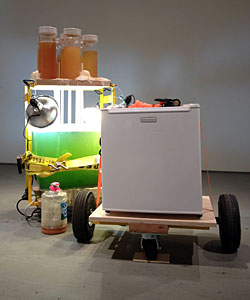
Artist Marissa Lee Benedict’s mead-maker.
It’s been three years since Grolsch stopped sponsoring local art openings, and in light of the drought, cheap alternatives such as 2-buck Chuck and PBR have popped up like ugly weeds in a well-tended garden. But now, Chicago galleries are overflowing with home-brewed hooch. SMaB, a collective of artists in Pilsen, and Marissa Lee Benedict, whose mead is currently brewing in the West Loop, are among the most fascinating projects on the scene.
Small Ass Brewing, or SMaB, is five artists (Benjamin Bellas, Paul Hopkin, C.C. Ann Chen, Jeffrey Grauel, and Brent Garbowski) who together create small batch beer—typically around 50 bottles—for each Slow Gallery exhibition. At Slow Gallery, which is run out of Hopkin’s Pilsen apartment, imbibing is part of the viewing experience. SMaB is currently working on a peanut butter and jelly beer in addition to a blueberry white tea stout and a beet red rye.
I asked Hopkin whether the brewing project is art. “I don’t care,” he replied. “It’s nice to drink a good beer. It’s nice to look at a beautiful painting.” Introducing creative craft beer in this context, however, is reason to consider the artistic quality. Brewing is certainly a personal exploration for Hopkin. For instance, in a newer beer batch, he chose the bitter herb horehound both as an exploration of brewing history and Mormonism—Hopkin is an ex-Mormon. Horehound was once used to make a bitter-tasting medicinal Mormon ale. “I’ve geeked out on those types of things.”
In another part of town, the Chicago Artists’ Coalition gallery has been transformed into a mead-brewing center for Marissa Lee Benedict’s installation, The universe is formed by a series of feedbacks, positive and negative. Visitors to Benedict’s exhibition can reserve a bottle of her mead (or honey wine) for $10 or offer an equal-value item to barter. She’s almost 80 percent sold out, and some may have to wait another three months for the next batch, but Benedict says it’s “wonderfully inconvenient” to adhere to the production cycles of living things. In her artwork, algae is bred from the byproduct of the mead production, which Benedict will later transform into biodiesel.
While Benedict is a self-admitted “research junky,” and perhaps more interested in the production of biodiesel from mead than getting people drunk at an art event, she still appreciates that the Drumbar mixologist Benjamin Newby) spent the opening reception mixing Benedict’s mead with Hennessy Black, even if Benedict’s bottles of mead are intentionally un-branded. Benedict and Hopkin are often asked if their alcohol distribution is legal, it is. Since Prohibition it has been legal to serve drinks at home and in art galleries.
Like Benedict, Hopkin is interested in the idea that DIY alcohol both is and isn’t art. It’s a way “to get rid of the art object,” says Hopkin of both brewing creative new beers for free distribution and alternative, experimental art in general. As a form of conceptual performance art, gallerybrewing seeks to immerse viewers in the creative experience.
Marissa Lee Benedict’s mead is available at the Chicago Artists’ Coalition, 217 N Carpenter, through January 3, 2013. SMaB is available is Slow Gallery, 2153 W 21st, on February 2, 2013.
Jason Foumberg is Chicago magazine’s contributing art critic.
Photograph: Marissa Lee Benedict


